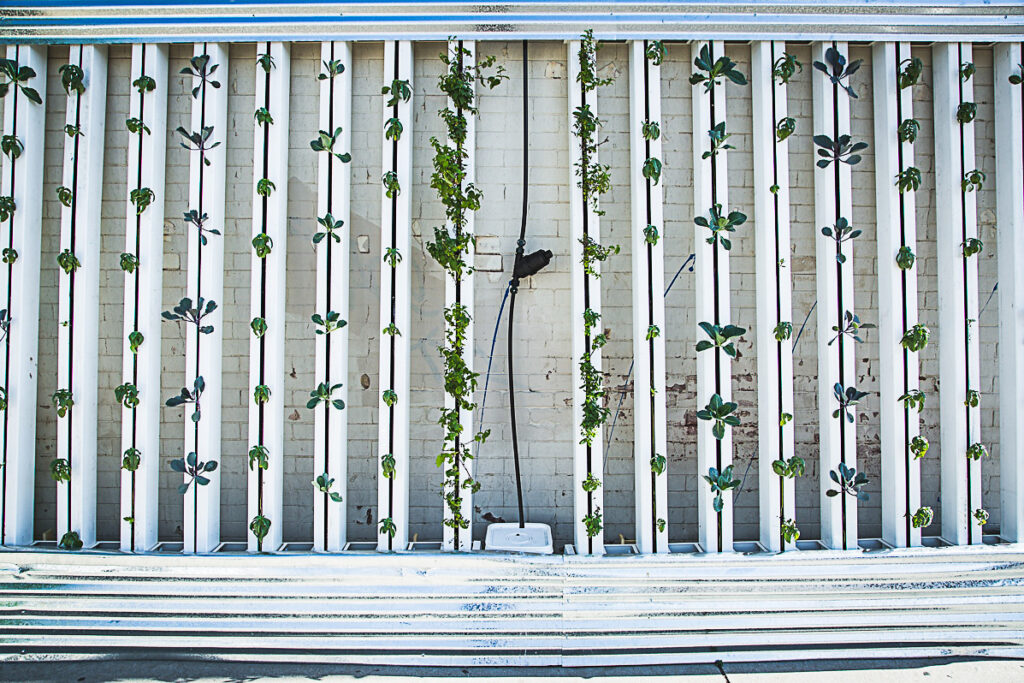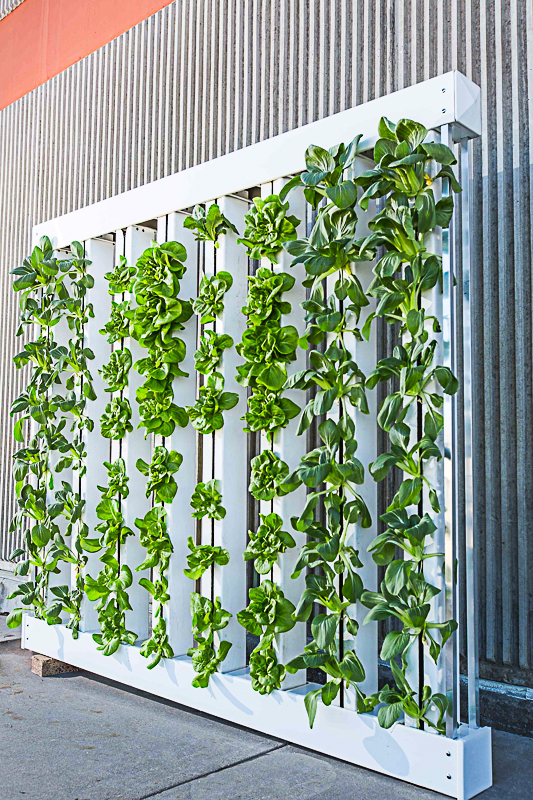With the current rapid changes in gardening technology, vertical hydroponics has found itself amongst the advancements. Gardeners are moving away from soil gardening and adopting hydroponics, a hassle-free method. Gravity plays a very vital role in a vertical hydroponic system by ensuring water flows to the plants. Here we help identify vertical hydroponics and provide tips on how to use this system of gardening at home.
*This post contains compensated links. Find more info in my DISCLAIMER. As an Amazon Associate, I earn from qualifying purchases.
Want to start a hydroponic garden at home easily? Check out our recommendations for Best Hydroponics Starter Kits for Beginners.
What Is Vertical Hydroponic Growing?
Vertical hydroponic growing is a system of growing plants in a vertical manner. This system works by use of conventional hydroponic techniques in a vertical system that uses gravity. The solution rich in nutrients is fed from the top and collected from the bottom.
Crops that do well under vertical hydroponics are kale, spinach, broccoli, lettuce, herbs, Swiss chard, strawberry, and flowering petunia.

Vertical Hydroponics Vs. Other Hydroponic Systems
Each method has its advantages and disadvantages. Looking at the benefits and challenges of all hydroponic systems methods will help gardeners, especially those who are new in the field, to make the right decision on which method to use. Plus, you can always choose more than one method for easier comparison.
Vertical hydroponics have various benefits compared to other hydroponics systems. However, not every method will do well for every plant. Some may do well in vertical hydroponics, and some may not. Thus it is best to try out all the methods to see which one works the best for them and for which plants.
How Does A Vertical Tower Hydroponic System Work
Vertical hydroponics systems utilize conventional hydroponic methods in a vertical gravity-fed system. In a vertical hydroponic garden, water and nutrients are fed from the top and collected from the bottom.
You can use different hydroponic techniques in your vertical garden, including the nutrient film technique (NFT) or ebb and flow technique. However, due to the dynamics of vertical grow systems, NFT is the easiest.
NFT involves a constant thin stream of nutrient-rich water flowing over the roots of the plants. It is a closed, continuous flow system, thus perfect for a hydroponic tower.
The idea of a hydroponic tower is to use a tube system connected to a pump to push water to the top layers. Gravity will then assist in channeling the water back to the reservoir. You can set up a single tube to get water to the top layer or multiple channels for optimal delivery of nutrients and water.
A DIY rain tower vertical hydroponic system consists of thicker drainage or PVC pipes for the central tower. Smaller holes are drilled into the main tower to host the individual plants. The plants are housed in net cups, which allow water to flow through the roots. Plants are typically grown at an angle of about 45 degrees.
A single hydroponic tower garden can hold up to 28 plants. You can have two tower gardens in a five-by-five-foot area to maximize your limited space. However, you can modify the design to suit your preferences.
You will require artificial lighting for indoor verticle grow systems. The best option is to use vertical grow lights because the plants in the tower are placed at an angle. Lighting panels hanging from the ceiling will not provide light to all growing surfaces uniformly because the plants are at different heights.
What Are The Advantages Of Vertical Growing Systems
Vertical grow systems have numerous advantages over traditional growing techniques. These benefits include:
Space Saving
Space utilization is the main reason experts advocate for vertical gardening. It is ideal for urban farming because you can grow more crops in a small space, even indoors. For example, a hanging hydroponic garden will only require a small footprint. Therefore, you can take advantage of the vertical space to grow more plants.
Year-Round Crop Production
Vertical farming is not dependent on the weather, allowing you to achieve reliable and consistent year-round production. You no longer have to worry about adverse weather affecting the quality and quantity of your yield. Farming in a well-monitored, protected, and controlled environment gives the grower assurance by minimizing the effects of mother nature.
Minimal Water Usage
Another significant advantage of vertical hydroponics systems is that the technique uses only about 10 percent of water. As a result, this farming technique also utilizes fewer nutrients and fertilizers. The water used is clean, allowing it to be recycled and reused, minimizing waste and reducing costs.
Environmentally Friendly
Vertical farming is good for the environment because it significantly reduces the use of farming equipment needed to sow, weed, and harvest crops. Furthermore, it helps improve biodiversity by not disturbing the land surface, allowing natural animals and organisms around farms to thrive.
Minimal Chemicals And Pesticides
Vertical farming, when managed correctly, can minimize or eliminate the need for chemicals and pesticides. Pests rarely enter a controlled environment to damage crops. In addition, fungal diseases struggle to survive because of the controlled humidity levels.
Benefits Of Vertical Hydroponics
These benefits include but are not limited to:
- Vertical hydroponics is a suitable method for limited areas such as patios, rooftops, or balconies. You, therefore, do not have to worry about owning big chunks of space to incorporate the system.
- There is a significant density yield per unit area with excellent quality produce. Research shows that any food produced hydroponically has double yields compared to soil-based crops and has an exquisite flavor.
- There is an all-year-round production, especially in microclimates such as greenhouses where temperatures are controlled.
- There are no cases of soil-borne diseases because soilless media is used.
- It gives approximately 90% efficiency in water use. Rather than being absorbed or disposed of, water is recirculated.
- You can use this method both indoors and outdoors without any difficulties.
- You can easily control the nutrients supplied to the plants. The nutrients are fed to the plants in the required quantities.
- There are no strict maintenance practices such as weeding or digging of weeds as in soil gardening. The only maintenance needed is close monitoring of the system so that it doesn’t fail.
- Chances of repotting are few since the plants are not root-bound. Repotting may be tricky because the young plants do not have a stable root system to support themselves.
Where To Buy A Vertical Hydroponic Tower
You can purchase a vertical hydroponic tower from online stores such as Amazon at very affordable prices. Here’s one of our favorites and it’s perfect for home gardeners.
Mr Stacky Hydroponics Tower

These systems are a perfect choice for gardeners who want to grow many crops but do not have adequate space instead of worrying about having large growing areas. Mr. Stacky grows vertically. This means the plants are grown on top of each other and not next to each other, requiring less space.
The growth pattern gives rise to an appealing and unique system. It is the greatest strength of this system because no other model can be used to grow a similar number of plants in a small area in your house or garden.
The growth rate of plants in this system is impressively fast, and it is excellent for beginners and intermediates.
Check pricing here.
How Do You Use A Vertical Hydroponic Tower At Home?
A hydroponic garden tower is a system that comprises vertical hydroponics, which includes cascades of bottles, hydroponic walls, and an A-frame hydroponic system. A tube is connected to a water reservoir at the base, and a hydroponic pump helps to pump water to the top.
With the aid of gravity, water is brought down in a precise manner back to the reservoir, and in this process, nutrients are delivered to the plants.
Plants are put in net cups, at 45 degrees so that the water can easily flow through roots. You can install numerous channels in the system to channel water and nutrients to the plants.
How It Works

To set up a vertical hydroponic planter tower, you will start by purchasing a hydroponic kit from any store. The kit comes with instructions on how to set up the system. Since it is easy to set up, you will not encounter problems.
However, there are several things to be looked at. You have to ensure the lower plants do not drown and, similarly, ensure that the tanks do not run out of water, drying up the plants. It would be best if you also kept an eye on the water flow in the stack so that the plants are watered enough.
It is also necessary to do close supervision of the supplemental light provided because hydroponics rely so much on the light. For natural lighting, ensure the plants receive light for 14 hours a day. When supplementing light, you can do so for some limited amount of time or all year round, depending on the season or the crop needs.
Lastly, you ought to check the nutrient mix provided to the plants. A drop in the tank solution means the nutrient concentration will be high; hence they should be monitored closely. If all these are well taken care of, your system will run smoothly.
There are four types of vertical hydroponics; A-frame, zigzag, rain tower, and vertical gutter garden.
A-Frame Hydroponic System
It is the best setup for growing plants in a small space since the yields will definitely be high. Since there are several pipe layers, you will also require several tubes.
The pumping system will be somehow complicated because water does not flow in one direction only.
However, it is not something to worry about because it is manageable.
Zigzag Hydroponic System
This vertical hydroponic system design also saves on space, grows many plants, and produces high yields. It is an easy DIY process when you have PVC pipes, and you follow the instructions provided carefully. However, the pumping may be somewhat complicated, but once you become an expert, it is the best system ever.
Rain Tower Hydroponic System
This system is the usual and efficient tall tube hydroponic system. It uses water efficiently and has the best water flow. It is an easy DIY process too.
Vertical Gutter Garden
Ever thought of having a gutter hydroponic system? Well, a vertical gutter garden is one of the most creative gardens one can have. This system essentially uses rainwater that is collected in gutters. It is a simple system and can be created by any enthusiastic gardener.
Check out our recommendations for the best Vertical Aeroponics Towers.
FAQs – Vertical Hydroponics For The Home
Both vertical and horizontal hydroponics have many advantages. Which is better is depends on the user. If you are limited on space, then a vertical system is better. If you are growing plants that require more space, then horizontal. Regardless of which system, they are both equally effective in growing plants.
Vertical hydroponic systems have revolutionized the way we grow vegetables. Suited for small spaces, they are ideal for new home gardeners. In addition to occupying a small footprint, vertical hydroponic systems allow for maximum growth from a variety of plants.
Vertical farming isn’t necessarily better than horizontal farming. Each produces larger yields compared to traditional soil farming. However, certain plants such as lettuce, grow better using vertical farming compared to horizontal farming.
